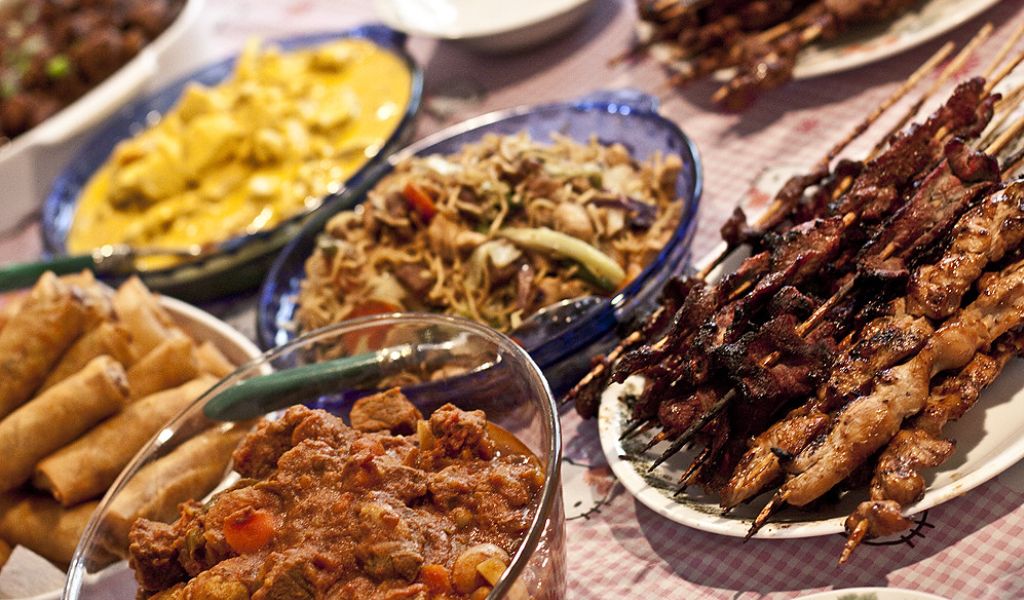Street Foods in the Philippines – Let’s Get Grubbing on the Go in the Philippines!
Welcome to the vibrant, colorful world of Filipino street food – a true feast for the senses and the adventurer’s soul! If you’re ready to tantalize your taste buds and dive into a world of exciting flavors, you’re in the right place. The Philippines isn’t just famed for its stunning beaches and warm hospitality; it’s also a haven for foodies who dare to explore its bustling streets and savor every bite of its delicious street food offerings. From the smoky aroma of grilled meats to the heavenly sweetness of tropical treats, each bite tells a story of culture, tradition, and sheer culinary delight.
1. The Sizzling Sisig Sensation
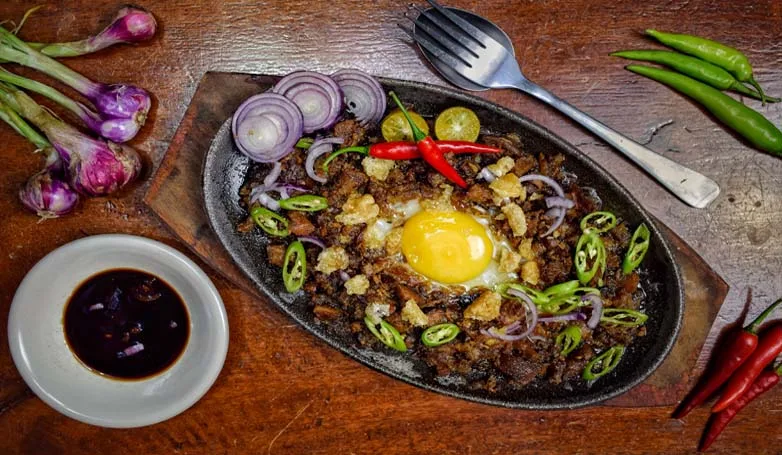
Sisig is a quintessential Filipino street food that has captivated the hearts and taste buds of locals and tourists alike. Originating from Pampanga, this sizzling dish is traditionally made from finely chopped pig’s head and liver, seasoned with soy sauce, vinegar, onions, and chili peppers, then served on a hot sizzling plate.
The distinctive sizzle and aromatic steam that rises from the dish as it’s served is part of its allure. Modern variations of sisig now include options made with chicken, fish, or even tofu, but the original pork version remains the most popular. Often topped with a raw egg and served with a side of rice, sisig is a perfect balance of smoky, tangy, and spicy flavors, making it an irresistible snack or meal for any time of the day.
2. Balut: Braving the Duck Embryo Delicacy

Balut is one of the most infamous and adventurous street foods in the Philippines, challenging the boundaries of culinary tradition with its unique combination of flavors and textures. This delicacy consists of a fertilized duck egg, boiled to perfection, and typically eaten while still warm.
The egg contains a partially developed embryo, which gives it a distinct, savory taste and a soft, tender texture that contrasts with the firmer egg white. Balut is usually seasoned with a pinch of salt, pepper, and a splash of vinegar, and it’s often enjoyed with a side of fresh herbs or spicy chili.
While some may find the idea of eating an embryo unsettling, balut remains a beloved comfort food, celebrated for its rich, flavorful profile and its deep connection to Filipino street food culture. Whether enjoyed as a late-night snack or a social food shared with friends, balut continues to be a symbol of boldness and Filipino culinary ingenuity.
3. Sweet Banana Cue Bliss
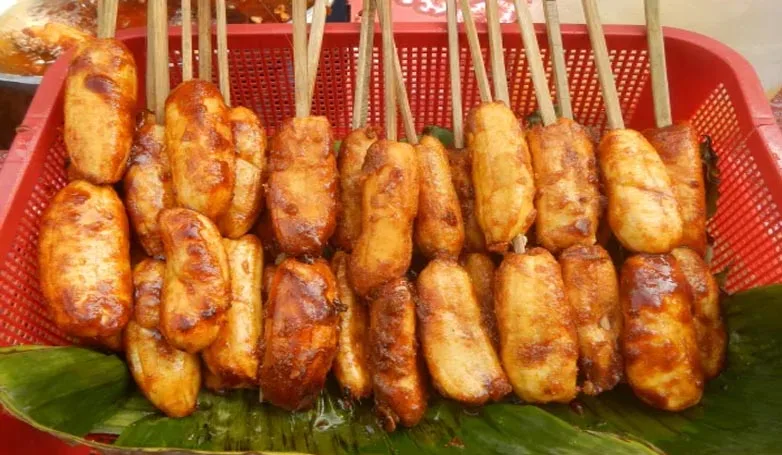
Banana Cue is a popular and indulgent Filipino street food that brings together the perfect balance of sweetness and warmth, making it an irresistible treat for people of all ages. This snack features saba bananas—large, starchy bananas that are native to the Philippines—coated in brown sugar and then deep-fried until golden and crispy.
The caramelized sugar forms a crunchy, sweet coating around the soft, tender banana inside, creating a delightful contrast of textures. Typically served on a skewer for easy handling, banana cue is often enjoyed as a quick snack while strolling through local markets or as a street-side treat. Its simple yet satisfying flavor, combined with the nostalgic appeal, has made it a staple of Filipino street food culture, offering a blissful experience with each bite.
4. Sinfully Good Chicharon
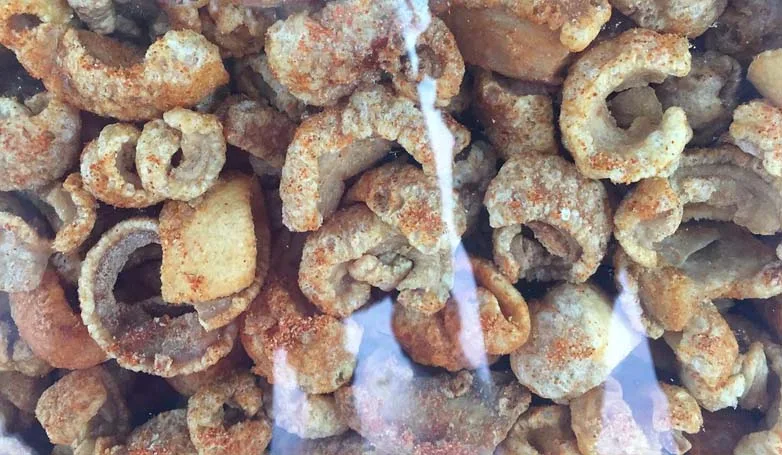
Chicharon, a beloved Filipino street food, is a deep-fried delicacy that offers a crispy, crunchy experience with each bite, making it a tempting treat for snack lovers. Made from pork skin (or sometimes pork belly), the meat is carefully seasoned and then deep-fried until golden brown, resulting in an irresistibly crunchy exterior and tender, flavorful interior. The result is a snack that’s both savory and indulgent, often enjoyed with a side of vinegar or spicy dipping sauce to complement its rich taste.
Chicharon is a popular choice at street food stalls, markets, and as a companion to beer in casual gatherings. Whether eaten as a quick bite on the go or served as part of a larger meal, chicharon’s satisfying crunch and addictive flavor make it a sinfully good comfort food that Filipinos and visitors continue to crave.
5. The Ultimate Comfort Food: Fish Balls

Fish balls are a quintessential comfort food in the Philippines, offering a deliciously simple yet satisfying experience for street food enthusiasts. Made from a blend of fish paste and starch, these round, bite-sized delights are deep-fried until golden and crispy on the outside while remaining tender and chewy on the inside.
What makes fish balls truly special is their versatility—served on skewers, they can be dipped into a variety of sauces, from sweet and tangy to spicy and savory, depending on personal preference.
Fish balls are widely available at street corners, markets, and food carts across the country, where locals often enjoy them as a quick snack or social food to share with friends and family. Their affordability, coupled with the comforting flavors, has cemented fish balls as a favorite street food that transcends generations, providing a sense of nostalgia and warmth with each bite.
6. Taho: The Soothing Silken Treat

Taho is a beloved Filipino street food that offers a comforting and sweet experience, perfect for starting the day or satisfying a mid-afternoon craving. This warm, silky treat is made from silken tofu topped with a generous drizzle of sweet syrup (known as sago or brown sugar syrup) and chewy tapioca pearls, creating a harmonious blend of textures and flavors. Traditionally sold by street vendors carrying large containers of taho, the treat is served in clear cups, often with a straw to sip up the syrup and pearls as you enjoy the tofu.
Its smooth, creamy consistency and sweetness make it a soothing and indulgent snack that brings comfort in every bite. Taho is a quintessential part of Filipino street food culture, often enjoyed as a morning treat, evoking a sense of nostalgia and warmth that resonates deeply with many Filipinos.
7. Squid Balls: An Oceanic Street Food Experience
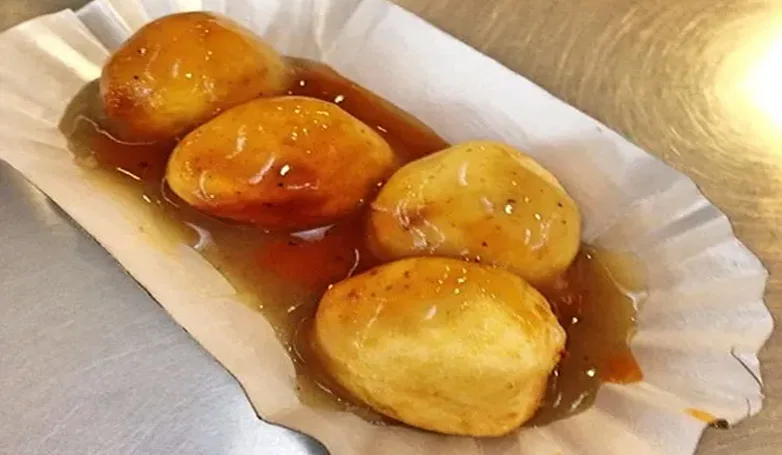
Squid balls are a popular Filipino street food that offers a unique, oceanic twist to traditional fried snacks. Made from minced squid, combined with starch and seasonings, these bite-sized treats are deep-fried to a crispy golden brown on the outside while maintaining a tender and savory interior. Often served on skewers, squid balls are typically enjoyed with a variety of dipping sauces, ranging from sweet and tangy to spicy, allowing each eater to customize their flavor experience.
The rich, savory taste of squid gives these balls an unmistakable seafood flavor, making them a favorite among seafood lovers. Whether eaten on the go, during social gatherings or as a satisfying snack, squid balls are an exciting and delicious street food that brings the fresh taste of the ocean to Filipino streets.
8. The Irresistible Pull of Isaw (Chicken Intestines)

Isaw, a popular Filipino street food, is a savory delicacy made from chicken intestines that has captured the hearts of many with its irresistible flavors and unique texture. The intestines are carefully cleaned, marinated in a flavorful mix of spices, and then grilled to perfection, giving them a smoky, charred exterior and a tender, juicy interior.
The grilling process enhances the rich umami flavor, making isaw a truly addictive snack. Typically served on skewers, it’s often enjoyed with a tangy vinegar dip or a spicy sauce to balance the savory notes. Whether enjoyed as a quick street-side bite or as part of a fun food experience with friends, isaw is beloved for its bold flavor and satisfying chew, embodying the adventurous spirit of Filipino street food culture.
9. Kwek-Kwek: The Orange-Hued Quail Egg Wonder
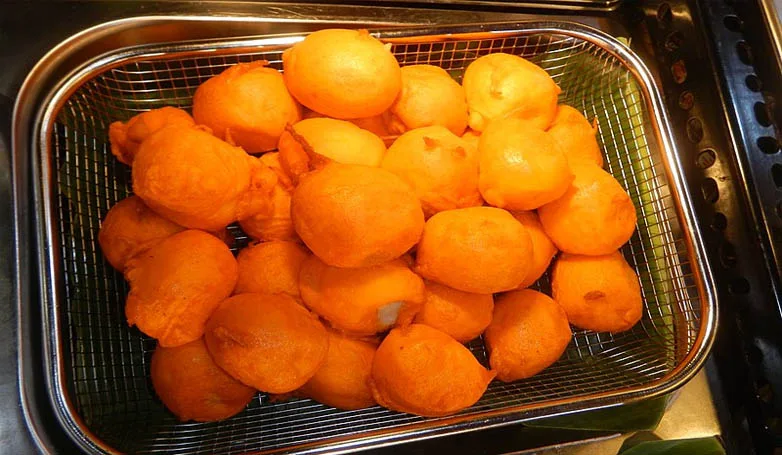
Kwek-Kwek is a beloved Filipino street food known for its vibrant orange coating and unique combination of flavors. This snack features hard-boiled quail eggs, then dipped in a thick batter and deep-fried until golden and crispy. The bright orange color of the batter is not only eye-catching but also signals the crispy, crunchy exterior that contrasts wonderfully with the soft, delicate quail egg inside.
Kwek-Kwek is typically served on skewers and often paired with a variety of dipping sauces, such as sweet, spicy, or vinegar-based options, to enhance its flavor profile. Its bite-sized nature makes it a perfect snack for on-the-go enjoyment, while its distinct appearance and satisfying crunch have made it a fun, flavorful part of Filipino street food culture. Whether enjoyed as a quick snack or a shared treat with friends, kwek-kwek continues to delight with every bite.
10. Turon: The Sweet Snack That Wraps It Up
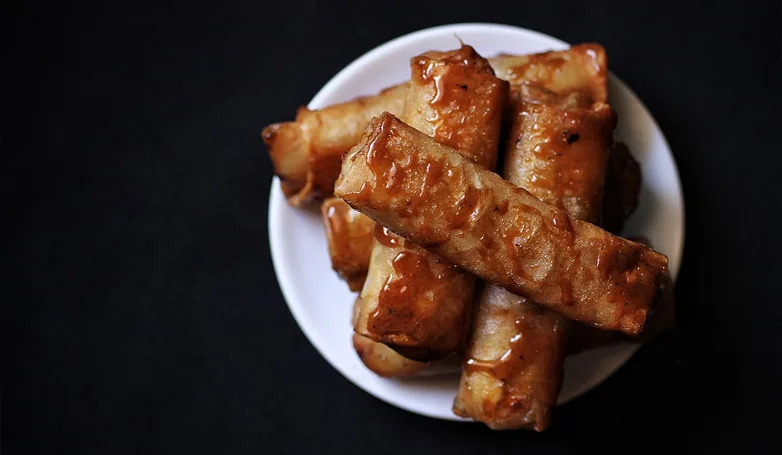
Turon is a popular Filipino street food that offers a delightful blend of crispy, sweet, and savory flavors in every bite. This snack consists of ripe saba bananas, often paired with a slice of jackfruit, wrapped in a spring roll wrapper, and fried to golden perfection. The sugar coating caramelizes as it fries, creating a sweet, crunchy exterior that beautifully complements the soft, sweet banana and jackfruit inside.
Turon is typically enjoyed as a quick snack, served warm and often dusted with a little extra sugar for an added touch of sweetness. Its simple yet indulgent nature makes it a beloved treat for Filipinos of all ages, and its combination of textures and flavors makes it the perfect balance of comfort and satisfaction. Whether enjoyed on the streets or as an afternoon snack, turon is the sweet wrap that everyone keeps coming back to.
The Grand Finale of Flavorful Feasting
Embarking on a street food adventure in the Philippines is not just about eating; it’s an excursion into a culture rich in diversity and flavors. From sweet to savory, from the earthy Sisig to the succulent sweetness of Banana Cue, Filipino street food captures the essence of the country’s love for delicious, hearty, and accessible cuisine.
Whether you’re a daring foodie looking for your next culinary conquest or someone seeking comfort in small bites of home-cooked goodness, the streets of the Philippines will never disappoint. The warmth of its people and the unforgettable taste of its street culinary treasures ensure you’ll leave with happy memories and a full belly. So, grab a stick, pick up a snack, and enjoy eating your way through one of Southeast Asia’s most flavor-packed destinations. Remember, in the Philippines, the humble street corner is where the heart (and stomach) truly finds its joy!
FAQs About Street Foods in the Philippines
1. Are street foods in the Philippines safe to eat?
The safety of street food in the Philippines can vary. It’s important to patronize vendors who follow good hygiene practices. Look for popular stalls with high turnover, and ensure foods are fresh and cooked properly. Tourists should use discretion and perhaps consult locals or guides about the best and safest places to try street food.
2. How do you find street food vendors in the Philippines?
Street food vendors in the Philippines are commonly found in public markets, outside schools and office buildings, transport terminals, food bazaars, and other busy public places. They often set up their stalls in the evening when people are looking for quick and affordable meals.
3. Can you find vegetarian options among street foods in the Philippines?
While many Philippine Street foods include meat or fish, there are vegetarian options available. Taho, Turon (banana wrapped in a lumpia wrapper and fried), and Nilagang Mani (boiled peanuts) are popular vegetarian-friendly street foods.
4. Can you find Filipino street food outside of the Philippines?
Yes, Filipino street food is gaining popularity in many cities around the world where there is a significant Filipino community. Festivals, Filipino restaurants, and food trucks in countries like the United States, Canada, and parts of Europe are including Filipino street food in their offerings.
5. Do street food vendors in the Philippines offer beverages as well?
Yes, many street food vendors also sell beverages. Buko juice (coconut water), Samalamig (refreshing sweet drinks like sago’t gulaman), and soft drinks are commonly available from street vendors.


